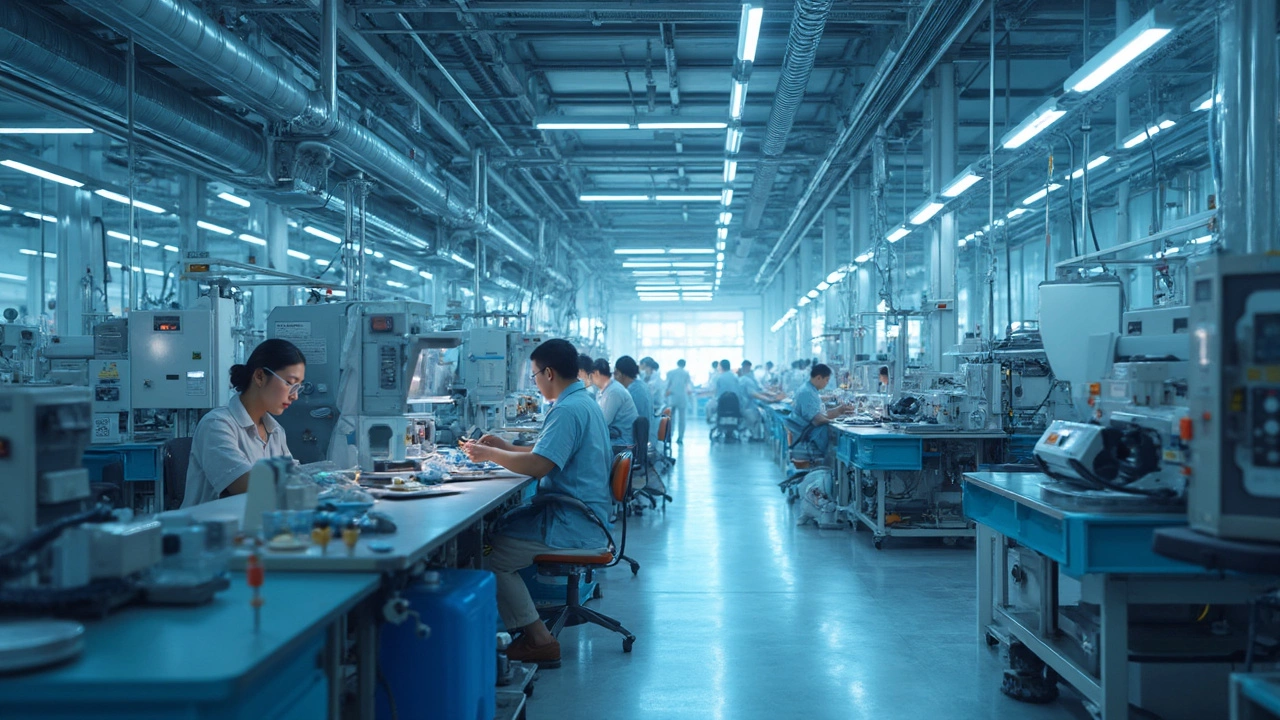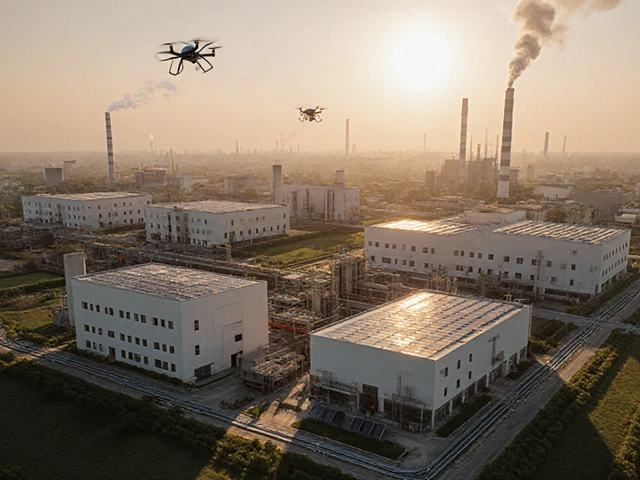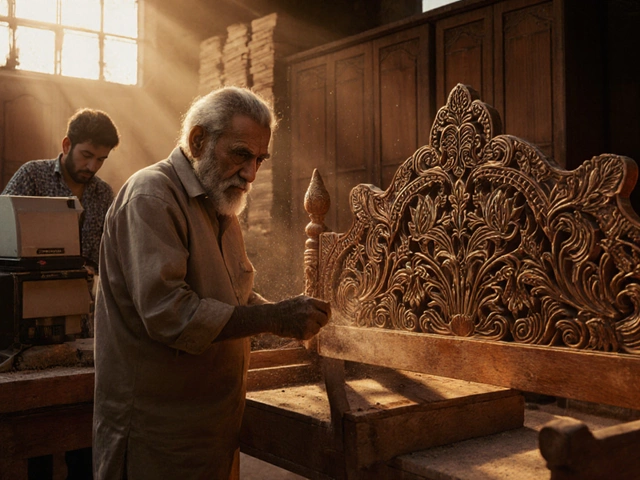Where's the Best Bargain for Manufacturing Your Products?

Ever wondered where you should get your products made without breaking the bank? You're not alone. As startups scramble to cut costs and maximize profits, the search for affordable manufacturing hotspots is fierce.
You probably think of China as the go-to for cheap manufacturing, right? Well, you're not wrong. But things have changed a bit. Let’s talk about China and its famous manufacturing might first. Labor might be cheap, but it's not as cheap as it once was. Plus, dealing with tariffs and geopolitics can make your head spin. So, what about India? With a young workforce and growing tech industry, it's a strong contender. But the infrastructure challenges can be off-putting.
- Introduction to Cost-Effective Manufacturing
- The Coin's Flip: China and India
- Vietnam's Rising Star
- Mexico's Neighborly Advantage
- Considerations Beyond Cost
- Tips for Successful Outsourcing
Introduction to Cost-Effective Manufacturing
Diving into the world of manufacturing can seem daunting, especially when you're looking to keep costs low without skimping on quality. For startups, this balancing act is crucial. But worry not – we're here to guide you through the essentials of cost-effective production.
First things first, why does the location of manufacturing matter so much? Well, it’s not just about the cheap production costs, but also about logistics, material availability, labor skills, and even taxes.
Key Factors to Consider
When it comes to finding a cost-effective place to produce your products, several elements come into play:
- Labor Costs: How much does labor cost in that region? Lower wages mean cheaper production costs.
- Infrastructure: Are there reliable transport and communication systems? Good infrastructure lowers operational headaches.
- Political Stability and Regulations: Check for any export-import restrictions or trade complexities that can add hidden costs.
- Proximity to Market: Shipping costs can eat your budget. Being closer to your main market can cut down on these expenses significantly.
Crunching Some Numbers
Let's put things in perspective with some average labor cost figures:
| Country | Average Hourly Wage (USD) |
|---|---|
| China | 6.50 |
| India | 2.50 |
| Vietnam | 3.00 |
| Mexico | 4.50 |
These numbers give a snapshot, but remember, they fluctuate with industry and skill level.
So whether you're contemplating tapping into Asia's powerhouses or giving Latin America a shot, understanding these basics is key. It's like plotting a journey; you need a trusty map to make sure you're heading in the right direction.
The Coin's Flip: China and India
Alright, let's dive into the world of manufacturing with two big players: China and India. Both have their own charm and challenges when it comes to cheap production. So, how do they stack up against each other?
China: The Veteran
China's reputation in manufacturing is legendary. From toys to tech gadgets, it's an absolute giant in the industry. The infrastructure is top-notch, with a fully developed supply chain that's hard to beat. Labor used to be dirt cheap too, though it’s creeping up these days.
One of the downsides? Geopolitical tensions and tariffs can make the costs unpredictable. Also, don't forget the conversations around intellectual property concerns that can worry some companies.
"China remains a vital global manufacturer. However, rising labor costs and tariffs have led to it being termed the 'workshop of the world' rather than the 'cheap factory of the world.'" - The Economist
India: The Challenger
India is emerging as a strong contender. With its massive, young workforce and a powerful tech sector, it's catching eyes fast. English proficiency helps smooth out communication, which is a big plus. The Indian government has also been aggressively promoting 'Make in India' to attract businesses.
The challenge? Infrastructure in some areas hasn't caught up yet. Logistics could be a hiccup, but many are betting on India’s potential to become a key player in cost-effective manufacturing.
When weighing the two, it often boils down to what exactly you're producing and how you plan on scaling up. Every business has its unique needs and quirks, so keep your specific context in mind when choosing a partner location for your manufacturing.
Vietnam's Rising Star
If we're talking about the cheapest place to manufacture products, then Vietnam is definitely in the conversation these days. Over the recent years, Vietnam has steadily climbed the ranks as a manufacturing powerhouse, attracting businesses with its low labor costs and favorable trade agreements.
First off, let's tackle labor costs. Compared to China, Vietnam's wages are significantly lower, which is a huge plus for cost-effective production. It's not just about the money, though. Vietnamese workers are known for their strong work ethic and increasing skill levels, particularly in industries like textiles, electronics, and furniture.
Strategic Location
Located right next to China, Vietnam offers easy access to the larger Asian markets. It also benefits from numerous trade agreements, like the Comprehensive and Progressive Agreement for Trans-Pacific Partnership (CPTPP) and the EU-Vietnam Free Trade Agreement (EVFTA), furthering its appeal as a manufacturing hub.
Government Support and Infrastructure
Businesses can expect strong support from the Vietnamese government, which has been keen to bolster its manufacturing sector. Incentives like tax breaks for foreign investments and improvements in infrastructure are helping make Vietnam more attractive. Yet, some challenges remain, like logistics and a still-developing supply chain, but the improvements over the years are undeniable.
"Vietnam's competitive labor costs and business-friendly policies make it a top choice for companies looking to set up shop in Asia," says a report from the International Trade Administration.
Challenges and Considerations
Of course, every rose has its thorns. Language barriers and regulatory hurdles can pose a challenge for new entrants. However, with strong due diligence and local partnerships, these can be navigated effectively.
Numerous companies like Samsung, Nike, and Intel have already set up manufacturing facilities in Vietnam. It's a testament to the country's capability to handle large-scale production demands while maintaining quality.
If you're exploring options for cheap production and haven't yet considered Vietnam, it might be time to take a closer look. With all its advantages, it certainly deserves a spot on your list of potential manufacturing destinations.

Mexico's Neighborly Advantage
When you're looking for a sweet spot in manufacturing, Mexico might just surprise you. It's like that underrated but awesome friend living right next door. Why? Well, let’s break it down.
Proximity Perks
Being so close to the U.S. offers big perks. Shorter shipping distances? Check. This means you save on transport costs and can get your products to market much faster. Plus, with similar time zones, it's easier to communicate and troubleshoot any issues in real time.
Trade Agreements
The United States-Mexico-Canada Agreement (USMCA) plays a huge role here. It simplifies trade and cuts out a lot of the red tape that can bog down international manufacturing dealings. So, for a startups looking to keep things simple, this is a real blessing.
Skilled Labor That's Cost-Effective
México isn’t just about cheap labor; it's about value. The country has invested heavily in educating a skilled workforce. From electronics to automotive industries, you’ll find highly qualified workers who know their stuff, all for competitive wages.
Industry Diversity
Beyond the traditional industries, Mexico is branching out into tech and renewable energy. This diversity is great for startups aiming to tap into new sectors with fresh ideas.
Potential Challenges
But hey, it's not all sunshine and roses. Security can be a concern, and the infrastructure, while improving, isn't perfect. When considering cost-effective manufacturing in Mexico, it's crucial to weigh these factors, perhaps visiting a few sites yourself.
So, when you're thinking about affordable manufacturing locations, don't forget to look south. Mexico might just be the right choice for your growing needs!
Considerations Beyond Cost
While nabbing the cheapest manufacturing deal sounds like a dream, there's more to the picture than just low prices. It’s not just about finding where manufacturing is cheapest. You’ve got to think bigger.
Quality is Key
First off, there’s quality. Imagine saving a few bucks now but having to recall thousands of faulty products later. Not cool, right? Quality control in places like China and India can vary widely, so it's crucial to ensure your partner can consistently deliver top-notch products. Site visits or hiring local inspectors could save you from massive future headaches.
Logistics and Infrastructure
Let's talk logistics. It’s a biggie. Having a factory in the middle of nowhere is only a win if you plan to camp there forever. You need good roads, ports, and local networks to ship your products efficiently. Vietnam’s on the up-and-up here, improving infrastructure year on year. Mexico also rocks in this department, especially for US businesses, thanks to its proximity.
Political Stability
Don’t overlook the political scene. Geopolitical tensions can affect trade, tariffs, and operations. Ensuring that your manufacturing country is politically stable can save a lot of uncertainty. Just look at how tariff changes have rocked the manufacturing industry in recent years.
Cultural and Language Barriers
Here's a kicker – language. Effective communication with your manufacturer can make or break your project. You might find yourself playing charades if you’re not on the same page, culturally speaking. Having a local partner or hiring a bilingual manager can bridge that gap and smooth out the process.
Supporting Local Economies
Lastly, think about the impact. Supporting a developing country's economy can be a good move for your brand's image. It shows corporate social responsibility, which consumers increasingly value. That warm fuzzy feeling, plus a better world.
So yeah, it’s not just about the bottom line. Look at the bigger picture, and you'll make a smarter, long-term decision.
Tips for Successful Outsourcing
Struggling to figure out outsourcing? It doesn't have to be a nightmare. Get it right, and it can seriously boost your manufacturing game. Let's break down some crucial tips to make it smooth and beneficial for your manufacturing venture.
1. Choose the Right Partner
Picking a partner is like dating—you wouldn't settle for just anyone. Look for factories with a solid track record in your industry. Check their reviews and get references. You want someone who's been around and knows what they're doing.
2. Clear Communication is Key
You don't need to be poetic, but being clear is essential. Ensure there are no gaps in understanding product designs or deadlines. This can save a ton of headaches down the road.
3. Protect Your Intellectual Property
No one wants their ideas snatched. Get legal advice on protecting your intellectual property, especially if you're manufacturing in countries where laws might be, well, kind of breezy about it.
"The success of your outsourcing strategy almost entirely depends on choosing the right partner and managing the relationship effectively." — Gartner Research
4. Build a Strong Relationship
A little human touch goes a long way. Regular visits, calls, and updates can cement a thriving partnership. Plus, you get the added benefit of keeping everyone on their toes.
5. Keep an Eye on Quality
Quality control can make or break your business. Don't just assume everything will be perfect. Implement rigorous QC checks at every stage of production to avoid any nasty surprises.
6. Cost Analysis
Sure, outsourcing seems cheaper, but double-check those numbers. Consider tariffs, shipping fees, and unexpected expenses. A simple cost-effective calculation table might save you:
| Expense | Estimated Cost | Actual Cost |
|---|---|---|
| Labor | Low | |
| Tariffs | Varies per country | |
| Shipping | Depends on distance |
Don't forget, your goal is not just saving money but ensuring your product rocks the market. So keep these steps in mind and give your manufacturing startup the head start it deserves.





